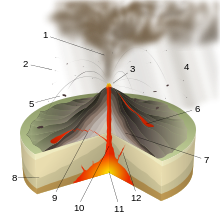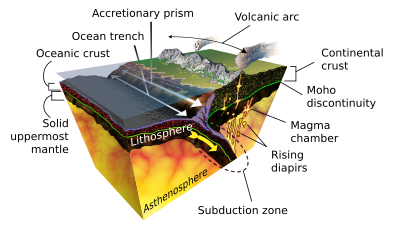Magma chamber

A magma chamber is a large pool of liquid
These chambers are hard to detect deep within the Earth, and therefore most of those known are close to the surface, commonly between 1 km and 10 km down.[3]Dynamics of magma chambers

Magma rises through cracks from beneath and across the crust because it is less dense than the surrounding rock. When the magma cannot find a path upwards it pools into a magma chamber. These chambers are commonly built up over time,[4][5] by successive horizontal[6] or vertical[7] magma injections. The influx of new magma causes reaction of pre-existing crystals[8] and the pressure in the chamber to increase.
The residing magma starts to cool, with the higher melting point components such as
Another effect of the cooling of the chamber is that the solidifying crystals will release the gas (primarily steam) previously dissolved when they were liquid, causing the pressure in the chamber to rise, possibly sufficiently to produce an eruption. Additionally, the removal of the lower melting point components will tend to make the magma more viscous (by increasing the concentration of silicates). Thus, stratification of a magma chamber may result in an increase in the amount of gas within the magma near the top of the chamber,[11] and also make this magma more viscous, potentially leading to a more explosive eruption than would be the case had the chamber not become stratified.
Supervolcano eruptions are possible only when an extraordinarily large magma chamber forms at a relatively shallow level in the crust. However, the rate of magma production in tectonic settings that produce supervolcanoes is quite low, around 0.002 km3 year−1, so that accumulation of sufficient magma for a supereruption takes 105 to 106 years. This raises the question of why the buoyant silicic magma does not break through to the surface more frequently in relatively small eruptions. The combination of regional extension, which lowers the maximum attainable overpressure on the chamber roof, and a large magma chamber with warm walls, which has a high effective viscoelasticity, may suppress rhyolite dike formation and allow such large chambers to fill with magma.[12]
If the magma is not vented to the surface in a volcanic eruption, it will slowly cool and crystallize at depth to form an
Often, a volcano may have a deep magma chamber many kilometers down, which supplies a shallower chamber near the summit. The location of magma chambers can be mapped using
As a volcano erupts, surrounding rock will collapse into the emptying chamber. If the chamber's size is reduced considerably, the resulting depression at the surface can form a caldera.[14]
Examples
In Iceland, Thrihnukagigur, discovered in 1974 by cave explorer Árni B. Stefánsson and opened for tourism in 2012, is the only volcano in the world where visitors can take an elevator and safely descend into the magma chamber.[15]
See also
References
- ISBN 9780521880060.
- ^ "Forensic Probe of Bali's Great Volcano". Eos. 12 February 2019. Retrieved 25 November 2020.
- S2CID 52064179.
- .
- .
- .
- doi:10.1139/E10-032.
- S2CID 129584032.
- ISSN 0026-461X.
- ISBN 9780080535401.
- ISSN 1460-2415.
- S2CID 44581563.
- doi:10.1130/B30720.1.
- S2CID 128985944.
- ^ Anita, Isalska (13 March 2014). "Only in Iceland: Descending into a volcano's magma chamber - CNN.com". CNN. Retrieved 15 June 2016.
